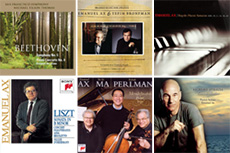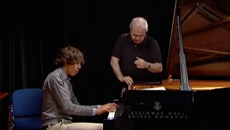Review: Emanuel Ax, Charles Dutoit, Boston Symphony Orchestra in fine form at Tanglewood
By admin on October 20, 2016 | Category: News | No CommentsBy
MassLive.com
13 August 2016
LENOX – Where was pianist Emanuel Ax on Friday night at Tanglewood when the audience was giving him and the Boston Symphony Orchestra a standing ovation?
You could see Ax, just off stage.
But as the crowd was urging him to come back out for another bow, Ax was doing some coaxing of his own. He was waving his arms and waiting to come back on stage until he was joined by conductor Charles Dutoit.
That little moment says a lot about Ax. It also would probably come as no surprise to Ax’s legions of devoted fans, some of whom wore T-shirts Friday that said, “Manny Ax ‘Maniax’.”
In a profession filled with prima donnas, Ax just might be one of the most laid back, down-to-earth, genuinely-nice musicians. Talk to people who know Ax and all of them talk glowingly about him. Ax could have easily returned to the stage on his own Friday to bask in the glow of thunderous applause. But he seemed more concerned with sharing the spotlight with Dutoit and the entire BSO.
So while Ax might be too modest to say so himself, let me clearly state that Ax definitely deserves to be considered one of the world’s greatest pianists. I have heard Ax perform several times – with the BSO, with star-studded chamber groups as well as with Ax’s longtime-friend Yo Yo Ma several times, including last summer, when they delivered a dazzling performance of Beethoven’s cello and piano sonatas. And every single time, I am always amazed by Ax’s ability to play each piece so beautifully, so lovingly.
Friday night was no exception. Right from the very first note, Ax performed Mozart’s Piano Concerto 22 in E Flat with a lighter-than-air touch. He vividly brought Mozart’s lively, precise music to life. He also amazingly played the music so softly at times and yet none of the notes were overpowered by the orchestra. How he’s able to play softly and loudly at the same time remains a mystery. However, I suspect it has something to do with the way Ax’s fingers caress the keyboard and gently produce one sparkling sound after another.
Ax’s performance Friday night was made even better by Dutoit, this year’s Koussevitzky Artist at Tanglewood. I barely noticed Dutoit conducting during Ax’s brilliant performance, which is what a great conductor should do – let the musicians shine. Far too often, far too many conductors flail their arms around like they’re trying to wave down a passing car while being chased by a chainsaw-wielding lunatic.
Dutoit takes a different approach. The stylish, suave conductor always brings an understated elegance to the podium. He rarely wears a tie or a full tuxedo. The times I’ve seen him conduct, he’s often wearing a white tuxedo jacket, a black shirt and black pants. On Friday, Dutoit didn’t have a jacket on. The man in black simply wore a button-down shirt and dress pants.
Throughout Friday’s concert, Dutoit moved gracefully like a dancer as he conducted the orchestra, his body often swaying slightly in time to the music. Dutoit’s most animated movements were reserved for his left hand, the one not wielding the baton. Often, his left hand moved gracefully, like an artist painting the notes in the air.
Other times, Dutoit’s hands became a little more animated during certain sections Friday night. But he never did so during the most moving, tender passages in Mozart’s piano concerto. There, Dutoit simply stepped back and let the BSO and Ax bask in the spotlight.
Mozart’s concerto was the second piece on the program, which began with Otto Nicolai’s overture to “The Merry Wives of Windsor.” Strangely, the lights were kept on during this short piece, taking away a little from the romantic ambiance of night concerts at Tanglewood. “The Merry Wives of Windsor” has a charming, swashbuckling flair. Listening to the piece, I half expected to see Errol Flynn swinging onto the stage, brandishing a foil.
After the Mozart concerto and a brief intermission, the BSO and Dutoit brought out the best in two beloved, classical music works – Claude Debussy’s “La Mer” and Mauice Ravel’s “Bolero.”
The orchestra sounded superb Friday performing “La Mer.” They perfectly captured the spirit of this luxurious music inspired by the ocean, especially the grand, sweeping sections that bring to mind waves crashing against the rocks or perhaps a three-masted schooner bursting through a large swell at sea.
Ravel’s instantly-recognizable “Bolero” never fails to delight audiences. On Friday, I even observed a few people dancing on the lawn just in back of The Shed as the orchestra played Ravel’s driving, seductive music. Maybe that’s because the music was originally written for a ballet.
On stage, Dutoit wiggled his hips a few times as well during “Bolero,” especially when several different instruments took turns playing the distinct, sinuous solo that drifts throughout the piece. But Dutoit didn’t go overboard. Like everything else he, Ax and the orchestra did Friday night, they did it with understated elegance and flair.



